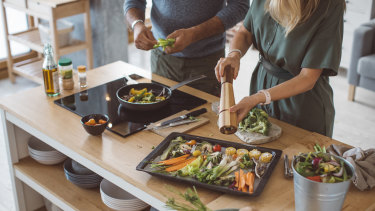How to embrace a ‘climate diet’

When the world is burning and the ice caps are melting, it’s hard to know what we, as individuals, can do to help the planet. Are our metal straws and reusable totes actually doing anything?
One thing that will have an impact on our individual environmental footprint is how we eat. Enter: the climate diet. Vegans have been spouting the environmental benefits of eating plant-based for years, but that’s just the tip of the (slowly melting) iceberg.
Getting smarter about how we’re buying and preparing food will be beneficial for our wallets as well as our planet.Credit:iStock
Choose your produce wisely
When you’re buying fruit and vegies, think “seasonal and regional”. If you’re trying to find summer fruits in the middle of winter, chances are they’ve been shipped in from the northern hemisphere. Avoid the unnecessary emissions and instead only buy what’s in season and preferably grown in your state.
Skip the supermarket and buy produce from the local fruit and vegie shop. Most source their stock from nearby farmers, so you’ll be getting fresher products anyway. And take your reusable bags along so your shop is totally plastic-free.
Limit your meat consumption
In the past 20 years, veganism has gone from a wacky lifestyle choice, to a trendy diet fad, to a normal and easy way of life.
But even if we all just agree to reduce our meat consumption, we make a difference. When choosing meals, keep in mind that beef, pork, and lamb are the worst offenders for greenhouse gas emissions. Chicken and fish are better options, especially when you buy from farmers or fish markets.
Local meat has reduced transport emissions, comes with less packaging, and is often a lot fresher. It’s a little pricier, sure, but you can balance it out by eating cheaper vegetarian options, such as beans or tofu, later in the week.
Avoid anything packaged
It’s near impossible to cut out all packaged food. But with a little planning you can drastically reduce your plastic use. Buy staples such as rice and pasta from bulk food stores, where you can bring your own containers. Pack snacks in Tupperware instead of buying pre-packaged. Always use a keep cup and refillable water bottle, take plastic tubs to the butcher instead of using bags and limit how often you get takeaway.
Don’t waste food
This sounds like a no-brainer, but one-third of Australian household waste is food. Being smarter about how we’re buying and preparing food will be beneficial for our wallets as well as our planet. Plan your meals and go grocery shopping with a list, so you only buy what you need. Find creative ways to use your leftovers: if a recipe only calls for half a zucchini, get on Pinterest and find a new dish you can prepare with the other half.
Keep vegetable peels and offcuts in a bag in your freezer and use them later to make your own vegetable stock. Instead of binning sad or soggy looking vegetables, chop them up and make a stew or blend them into a pasta sauce. Bruised or browning fruit can be frozen for smoothies, and leftovers can also be chucked in the freezer if you think you won’t get to them soon.
Basically, just remember that every little bit helps. If the majority of us do something, it’s going to have a much bigger impact than a small group of people trying to do everything. And when in doubt, shop local: eating vegan is all well and good, but if you’re relying on packaged snacks and processed food shipped in from the other side of the world, you’d probably be better off just eating locally sourced animal products.
Source: Read Full Article
